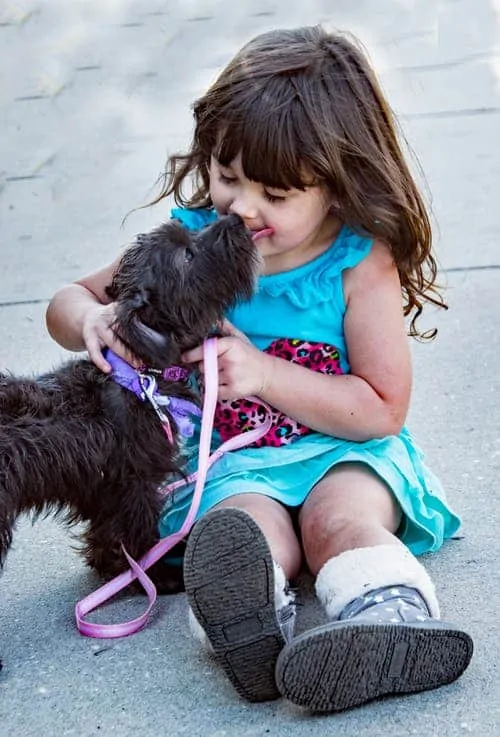Even if you haven’t recently found yourself looking into bringing home a new furry family member, you may have noticed that, over the last two decades or so, a new trend has hit the canine kingdom.
And that trend has everything to do with designer dogs.
But what is a designer dog? What is a crossbreed dog? And what on earth is a hybrid dog? And more importantly, are they really any healthier than purebred dogs?
Let’s find out!
Contents
What Is A Crossbreed Dog?
The designer dog, hybrid dog, and crossbreed dogs are one and the same, meaning that all three names are used to describe a particular type of dog that is specifically bred between two purebred parents.
The Schnoodle, for example, is a cross between a Schnauzer and a Poodle while the Labradoodle is a cross between a purebred Labrador Retriever and purebred Poodle. (Yes, there are many doodle, noodle, and oodle crosses).
A Labradoodle Crossbreed is a mix between a Labrador Retriever and a Poodle.
There are also different versions of crossbreeds.
First-generation crossbreeds, or crossbreed dogs that are the direct offspring of two different purebred dogs, are possibly the most controversial.
Second generation crossbreeds, crossbreeds that are the offspring of two of the same crossbreed parents) seem to cause less of a stir and be deemed more predictable. Of course, this is still just an opinion.
I have a second generation crossbreed.
Her grandparents are purebred Poodle and purebred Yorkshire Terrier. Her mom and dad, on the other hand, are both Yorkie-Poos, like her.
I bought her for a whopping (not gonna say how much) from a breeder and brought her home all happy to show her off to my parents. I’ll never forget the first thing my father said.
“You spent HOW much on a mutt?!”
But wait a minute. Axelle isn’t a mutt. She’s a designer dog. She’s a crossbreed. There’s a difference between a mutt and a crossbreed!
….Isn’t there?
Is A Crossbreed Really Any Different from a Mutt?
Are you wondering why we call the Goldendoodle a Goldendoodle and not just a mutt or mix? There is a reason, believe it or not, although I have yet to win with this argument at the dinner table.
Like most things crossbreed, the semantics over whether we should really just refer to crossbreeds as mutts has caused some issues.
But here’s the bottom line.
A crossbred is different from a mutt because it is the specifically designed offspring of two purebred parent dogs.
On the contrary, a mutt is more of an accidental mix of several different breeds that, should a DNA test be given, may go back generations.
It’s not always easy to tell between a crossbreed and a mutt, but to many breeders and dog lovers alike, there is a big difference between the two!
My father’s opinion on the matter? Hogwash. (He’s old school.) But you know what else is old school? Crossbreeding!
While this is a controversial practice as of late when it comes to the dog world, it’s actually nothing new.
The History of Crossbreeding
While it may seem that the designer dog trend really took off with Paris Hilton and all her miniature pups in handbags, the truth is that people have been crossbreeding dogs for centuries.
In fact, most of the purebreds we know and love today are the result of generations of careful crossbreeding by determined breeders and dog enthusiasts who have spent their time refining breeds by crossing different dogs in order to make a “purebred” with certain qualities.
One of the first records of crossbreeding dates back to the 14th century, when canine connoisseurs crossed the Greyhound and a terrier type to create a quicker, more agile hunter in the field.
Today, this dog is known as the purebred Lurcher.
The Longdog, a cross between a Greyhound and a Deerhound, is believed to be one of the earliest crossbreeds to date, dating all the way back to the 14th century.
Other modern-day purebreds that are a result of crossbreeding are some popular bully breeds, like the French Bulldog, Pitbull, and English Bulldog.
More specifically, the Frenchie is believed to be the refined descendant of small bulldogs crossed with Pugs, amongst other tiny breeds, to create the popular squishy faced little purebred we know and adore today.
So, since crossbreeding has been around for so long, why on earth is crossbreeding so controversial?
Let’s take a look.
Why is Crossbreeding so Controversial?
There are a number of reasons that crossbreeding today is somewhat of a touchy subject.
And while the lines are still a bit blurred and people still have differing opinions, the debate seems to circle around two basic issues.
1) Some feel that breeders irresponsibly design first generation crossbreeds and then sell them for as much as high-priced purebreds without the same health and temperamental guarantees.
2) Many experts straddle the fence as to whether crossbreeds may actually be healthier than purebreds.
Designer dogs have exploded in popularity over the past two decades, stirring a new wave of controversy amongst experts, breeders, and dog lovers alike.
Now, should the design dog debate be left up to scientists and doggy experts to argue over, or does this truly affect you and your future dog?
Well, it depends.
Like most things in this world, there are pros and cons to crossbreeding and pros and cons to purebred dogs.
Let’s weigh them out so you can decide for yourself which type of dog would be best for you.
The Pros and Cons to Crossbreeding
Pro – Crossbreeds do have better odds when it comes to health.
But does that mean crossbreed dogs are healthier in general?
Well, according to an article by Dr. Carol Beuchat that was published at the Institute of Canine Biology, crossbreed dogs tend to be healthier when compared to their purebred counterparts due to having a wider genetic pool and therefore a lower chance of inheriting certain genetic illnesses due to inbreeding.
One of the cons of crossbreeding is the certainty of temperament and personality. But this Yorkipoo seems just as loving as any dog we know!
And while this does not necessarily mean that crossbreeds are automatically healthier than purebred dogs, it does give them better odds.
Con – Crossbreeds, especially first generation crossbreeds, are not as predictable as purebreds.
This means aspects like appearance, size, and sometimes even temperament can be left up to chance. This also means that, unless you enter some private crossbreed contest, you cannot show your hybrid dog or have him registered by the American Kennel Club, as he is not an official breed.
The Pros and Cons to Purebreds
Pro – You pretty much know what you’re getting with a purebred.
There’s a reason that the Labrador Retriever is still one of the world’s most favorite dog breeds, even amidst a world of designer dogs.
According to the American Kennel Club, the Labrador Retriever is still crowned as America’s top dog!
He has an irresistibly cute face, a winning disposition, and minimal health issues. Best of all, you know that if you go to a breeder or a rescue and ask for a Lab puppy, that puppy is going to grow up to be between 21 and 25 inches tall and weigh around 50 – 80 pounds.
You also know he’ll either be yellow, black, or chocolate.
Con – Yes, sometimes purebreds actually are less healthy than crossbreed dogs due to irresponsible breeding practices through generations.
Unfortunately, very popular purebred dogs have been known to suffer the consequences of a rapidly shrinking gene pool.
This means that inbreeding is more of a risk to our purebred friends, which may lead to a number of serious health issues for them down the road.
What Are “Responsible Breeding practices”?
We hear the phrase “responsible breeding practices” quite often in the dog world, but what does it actually mean?
Well, this is one of the reasons that crossbreeding today is so controversial.
Breeders have a responsibility to make sure their puppies are as healthy as possible.
You see, in times past, breeders would crossbreed dogs for generations with the ultimate goal of refining the perfect breed of dog with the qualities they needed it for.
These days, our need for crossbreeding has changed from creating certain dogs to help us work and hunt to creating certain dogs who look a certain way, dogs who are smaller or larger, or dogs who are even smarter mostly (although not always) for companionship purposes.
But are breeders creating these hybrid dogs only to turn around and sell them too quickly? Should they wait for several generations and perfect these crossbreeds?
Who’s to say?
According to the American Kennel Club, there are guidelines that define responsible breeding practices.
Many experts agree that breeders should have the parent breeds health screened beforehand. They should have their litters screened and cleared for any health issues once they are born. They should follow up with proper vet visits, and the list goes on.
However, it’s important to note that even the dog breeders of old made some poor decisions that led to some of the most unhealthy purebreds of today.
In fact, generations of “refining” certain flat-faced breeds have led to a number of popular dogs today who suffer from several serious health issues, one of them being Brachycephalic Syndrome.
And while breeders do need to be held accountable for breeding responsibly, there is some responsibility that also falls on the potential owner.
Let’s take me and my dog, for example. As you now know, I have a Yorkie-Poo. And while she is the world’s most perfect and adorable little fluff nugget to walk the face of the earth, I know that Yorshire Terriers are notorious for having doggy dental issues.
This means her teeth could be shotty just due to genetics.
For this reason, my pup sees her vet regularly for teeth cleanings and I’ve invested in some pretty decent dental chews, toothbrushes, and doggy toothpaste.
So, Which Dogs Are Healthier – Crossbreeds or Purebreds?
As you have probably gathered by now, the answer to the above question isn’t so black and white.
And this, my friend, is why the design dog debate is such a controversial issue.
I suppose the most important thing for any dog lover or potential dog owner to keep in mind is that all dogs are prone to suffering from certain genetic health conditions, regardless of their parentage.
For example, canine hip dysplasia is common in many dogs, regardless of if they are crossbred or purebred.
And while certain hybrid dogs can be healthier than certain purebred dogs, certain purebreds may be healthier than hybrids.
So, a crossbreed dog or a purebred dog? Which one should you choose?
This is especially true if you have a crossbreed that is a mix between two notoriously unhealthy breeds.
Remember, the true test of health is going to come down not only to genetics but also to responsible breeding practices and the overall lifestyle of the dog (diet, exercise, routine vet checkups, etc).
Luckily, there are steps you can take to ensure your dog lives his best life, regardless of if he is a crossbreed or purebred.
Helping Your Dog Live His Best Life Regardless of His Breed or Crossbreed
It doesn’t matter if your dog is a mutt, a hybrid, or a purebred, there are plenty of factors that play a role in his health that go way beyond genetics.
If you can, I would recommend being as prepared as possible before bringing your new dog or puppy into your life.
Do some research on the type of dog or hybrid you are getting if you can, and make sure you are ready for some surprises because dogs are full of them!
Along with going through responsible breeders to select your puppy or rescuing your dog from a reputable shelter, I also suggest putting your dog on the healthiest diet possible.
Remember, puppies and dogs need food specified for their age, weight, and activity level, so be sure to read the packaging of your dog’s food and ask questions if you are unsure of the best kind of food for your particular pooch.
Not a fan of store-bought dog food? Don’t worry, you even have the option of making homemade dog food!
I also suggest making sure your dog gets plenty of exercise every day. The exercise needs of your dog will vary depending on his size, weight, age, and other factors.
And while smaller dogs may not need as much exercise and stimulation as their larger dog counterparts, it is still just as important to help them stay active and engaged to keep them healthy and happy.
I should also note that, like humans, dogs can become bored and depressed, which can have an adverse effect on their health.
Dogs who are especially active, social, and intelligent are most vulnerable to depression.
For these types of dogs, I highly recommend puzzle toys, kongs, and even hiring a dog walking service. You may even opt to take your dog to a quality doggy daycare center if you have a busy schedule and worry about him becoming bored or lonely.
Offering your dog a number of resources to help keep him mentally happy and active can not only improve his lifespan but can also help to lower his levels of stress and reduce his risk of getting sick.
So, what do you think? Are crossbreed dogs or purebred dogs the way to go? Share your thoughts in the comment section!

Madison Guthrie (also known as Sonny Mackenzi) is a pet care specialist and positive-reinforcement trainer who works most closely with anxious and reactive dogs. Born and raised in Littleton, Colorado, Madison developed a love for animals at an early age and spent most of her childhood outdoors rescuing stray pets and helping to rehabilitate injured wildlife. Along with animals, Madison also developed a love for writing and music. Over the past five years, she has worked to use her passions to help the pets and pet parents in her community build stronger bonds and live happier, healthier lives together. Currently, Madison lives in South Pasadena, California where she owns and operates Miss Madison LLC, a marketing company that focuses on helping privately owned veterinary establishments and pet care companies grow and thrive. She also works as a dog trainer at My Dog Spot, which is an award-winning pet care and training establishment in Pasadena, California.








